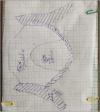Recipient Area
- PMID: 30886474
- PMCID: PMC6371721
- DOI: 10.4103/JCAS.JCAS_124_18
Recipient Area
Abstract
Recipient area is the canvas in a hair transplant surgery, where the surgeon can truly display his artistic creativity and deliver an aesthetic masterpiece, after all hair transplantation is as much about art as science. There are four main steps in dealing with the recipient area. Marking the hairline and estimation of grafts is the most important steps to give a natural look. There are multiple anatomical markers that need to be addressed while drawing a hairline. The second step is the anesthesia and it should be as painless as possible. This is followed by implantation, which can be achieved by various techniques. There are multiple technicalities to be considered while implanting, such as density, angle, and direction. Once implantation is done, the final step is appropriate postoperative care. Each of these steps has been discussed in detail in this chapter.
Keywords: Hair transplant; hairline design; implantation of grafts; recipient area.
Conflict of interest statement
There are no conflicts of interest.
Figures







Similar articles
-
An Innovative Training Model for Practicing Hairline Designing.J Cutan Aesthet Surg. 2018 Apr-Jun;11(2):83-87. doi: 10.4103/JCAS.JCAS_40_17. J Cutan Aesthet Surg. 2018. PMID: 30210211 Free PMC article.
-
Hairline design and frontal hairline restoration.Facial Plast Surg Clin North Am. 2013 Aug;21(3):351-62. doi: 10.1016/j.fsc.2013.06.001. Facial Plast Surg Clin North Am. 2013. PMID: 24017977 Review.
-
Hairline design in hair replacement surgery.Facial Plast Surg. 2008 Nov;24(4):389-403. doi: 10.1055/s-0028-1102903. Epub 2008 Nov 25. Facial Plast Surg. 2008. PMID: 19034816
-
The state of the art. Donor site harvest, graft yield estimation, and recipient site preparation for follicular-unit hair transplantation.Arch Facial Plast Surg. 1999 Jan-Mar;1(1):49-52. doi: 10.1001/archfaci.1.1.49. Arch Facial Plast Surg. 1999. PMID: 10937077
-
Follicular unit transplantation: dissecting and planting techniques.Facial Plast Surg Clin North Am. 2004 May;12(2):225-32. doi: 10.1016/j.fsc.2003.12.005. Facial Plast Surg Clin North Am. 2004. PMID: 15135132 Review.
Cited by
-
Construction of a Hair Implantation Needle Using Injection Needles and Assessment of its Efficiency Compared with Other Planting Methods.Aesthetic Plast Surg. 2024 Aug;48(15):2745-2750. doi: 10.1007/s00266-024-04001-5. Epub 2024 Apr 12. Aesthetic Plast Surg. 2024. PMID: 38609659 Clinical Trial.
-
Challenges in hair transplantation practice as a beginner.Indian J Dermatol Venereol Leprol. 2021 Mar-Apr;87(2):303-305. doi: 10.25259/IJDVL_281_20. Indian J Dermatol Venereol Leprol. 2021. PMID: 33769745 Review. No abstract available.
-
Summary of Best Evidence for Perioperative Management Practices in Hair Transplantation Patients : Facial Skeleton.Aesthetic Plast Surg. 2024 Dec;48(23):4791-4804. doi: 10.1007/s00266-024-04360-z. Epub 2024 Oct 8. Aesthetic Plast Surg. 2024. PMID: 39377788 Review.
-
Optimal Hair Transplant Recipient Site Slit Design: Minimizing Vascular Damage.Indian J Plast Surg. 2021 Dec 31;54(4):471-476. doi: 10.1055/s-0041-1739251. eCollection 2021 Oct. Indian J Plast Surg. 2021. PMID: 34984087 Free PMC article. Review.
References
-
- Rose PT, Parsley WM. The science of hairline design. In: Haber RS, Stough DB, editors. Procedures in cosmetic dermatology. Hair transplantation. Philadelphia, PA: Elsevier Saunders; 2006. pp. 55–72.
-
- Shapiro R. Creating a natural hairline in one session using a systemic approach and modern principles of hairline design. Int J Cosm Surg Aesthetic Dermatol. 2001;3:89–99.
-
- Unger W. Chapter 6A. Hairline zone. In: Unger W, Shapiro R, editors. Hair transplantation. 5th ed. New York: Informa; 2011. pp. 133–40.
-
- Chang SC. Estimation of number of grafts and donor area. Hair Transplant Forum Int. 2001;11:101–3.
-
- Unger WP. Density issue in hair transplantation. Dermatol Surg. 1998;24:297. - PubMed

